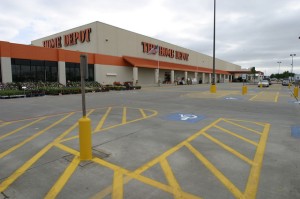Part One (of Three)
 When you look at a piece of prepainted metal, what do you see? Certainly a colorful article that may or may not have some shape to it. Often the metal is fabricated with “ribs” to add structural strength to the panel, or it may be flat, as is the case with a metal composite material (MCM) panel. The surface of the prepainted article might be a smooth, homogeneous surface, or it may have a wood-grained pattern, or it might have a subtle pebbly texture. The color of prepainted metal ranges from whites, grays, and blacks to neutral earth tones to saturated, brilliant colors. Some of the colors have metallic or color-shifting effects. But this layer of color is only what you actually see. What you don’t see is all that is under the surface.
When you look at a piece of prepainted metal, what do you see? Certainly a colorful article that may or may not have some shape to it. Often the metal is fabricated with “ribs” to add structural strength to the panel, or it may be flat, as is the case with a metal composite material (MCM) panel. The surface of the prepainted article might be a smooth, homogeneous surface, or it may have a wood-grained pattern, or it might have a subtle pebbly texture. The color of prepainted metal ranges from whites, grays, and blacks to neutral earth tones to saturated, brilliant colors. Some of the colors have metallic or color-shifting effects. But this layer of color is only what you actually see. What you don’t see is all that is under the surface.
In this three-part series, we’ll explore the three “building blocks” of prepainted metal and how they are equally important in forming a durable, beautiful, and functional material. We’ll learn how the stunning aesthetics—the colors and textures—of the surface coating enhance the critically important components that underlie the surface, and then we’ll show how it all comes together to provide a prepainted metal product that provides long-lasting performance.
 We’ll start with Part One: “The Hidden Strength.” As with an iceberg, there is much that lies beneath the look at “The Visible Beauty,” where we’ll learn about color, texture and all of the aesthetic qualities that make prepainted metal so appealing. Finally, we’ll present Part Three, “The Functional Capability,” a subject often taken for granted, but one that is just as important as the visible beauty and inner strength of prepainted metal.
We’ll start with Part One: “The Hidden Strength.” As with an iceberg, there is much that lies beneath the look at “The Visible Beauty,” where we’ll learn about color, texture and all of the aesthetic qualities that make prepainted metal so appealing. Finally, we’ll present Part Three, “The Functional Capability,” a subject often taken for granted, but one that is just as important as the visible beauty and inner strength of prepainted metal.
The Hidden Strength
At the core of a prepainted article is the base metal. It may be cold-rolled steel or aluminum. This base metal provides the critical strength properties of the prepainted article. Aluminum base metal is inherently corrosion-resistant, but the same cannot be said of cold-rolled steel. It is subject to corrosion, which is why prepainted metal uses  “metallic-coated steel,” which—just like it sounds—is cold-rolled steel that has been coated with a metallic layer, usually applied in a “hot dipped” process, to protect the base metal from corroding. Metallic coatings for cold-rolled steel are usually made of zinc, a blend of zinc and aluminum, or a blend of zinc and magnesium, which may also be modified with a small amount of aluminum. Whatever the chemistry of the metallic coating, prepainted aluminum and metallic-coated steel are designed to provide decades of corrosion-resistant performance, and the base metal chemistry used in prepainted applications is carefully controlled to provide the proper levels of strength and ductility.
“metallic-coated steel,” which—just like it sounds—is cold-rolled steel that has been coated with a metallic layer, usually applied in a “hot dipped” process, to protect the base metal from corroding. Metallic coatings for cold-rolled steel are usually made of zinc, a blend of zinc and aluminum, or a blend of zinc and magnesium, which may also be modified with a small amount of aluminum. Whatever the chemistry of the metallic coating, prepainted aluminum and metallic-coated steel are designed to provide decades of corrosion-resistant performance, and the base metal chemistry used in prepainted applications is carefully controlled to provide the proper levels of strength and ductility.
A shiny piece of metal has its place in our daily lives, but is often not what the consumer is interested in when choosing prepainted metal for building products applications, the largest market for prepainted metal. They want color! And color is easy to understand, because that’s what we see. We could discuss color for days and still not cover all the possibilities that prepainted metal can offer. (We will discuss color in Part Two.) But first let’s explore how the metallic substrate is transformed into the colorful, useful prepainted products with which we are familiar.
All metal substrates that are to be prepainted must be carefully cleaned and pretreated before receiving a coil-coating paint. Coil-coating production lines are designed with this process in mind. During the cleaning process, all contaminants are removed, creating a pristine surface that is ready to be pretreated. This pretreatment process provides two critically important needs: it converts the surface of the metal substrate to one that has enhanced corrosion resistance and at the same time it creates a compatible surface chemistry for the paint coating that will be immediately applied. (NOTE: The coil-coating process is a continual process. Metal is cleaned, then pretreated, and then painted in one continuous pass through the coil line.) Although many paints adhere well to metal, they adhere really well to properly cleaned and pretreated metal.
Often the first coating to be applied to the cleaned and pretreated metal is a primer, although there are some applications where a primer is not necessary. A primer’s principal job is to provide an excellent base for the coil-coated topcoat. It also provides some additional corrosion protection.
The topcoat is applied next, but we’ll talk about that in Part Two.
 To sum up: The Hidden Strength components of prepainted metal are mechanical strength, corrosion resistance, and an excellent base upon which to apply coatings. And not generally known by the casual observer of prepainted metal but fascinating to learn is the rate at which metal is processed—cleaned, pretreated, primed, topcoated—on a typical coil-coating line. The metal strip is processed at speeds up to 700 feet per minute, and the strip itself is usually about four feet wide (but it can be wider—sometimes up to six feet wide). To calculate the capacity of such a coil line, if a metal strip four feet wide is processed at a rate of 700 feet per minute, that means the line can process 2,800 square feet per minute. Of course, not all coating lines operate at this speed, so let’s say a typical value may be 1,500 to 2,500 square feet per minute. At this rate, the amount of coil-coated metal painted in just 30 minutes would wrap a Home Depot store. Most other application processes (such as spray painting) require at least 10 times as much time to equal to area coated by the coil coating process . No other painting process is as fast, as tightly controlled, and as environmentally friendly as the coil coating process.
To sum up: The Hidden Strength components of prepainted metal are mechanical strength, corrosion resistance, and an excellent base upon which to apply coatings. And not generally known by the casual observer of prepainted metal but fascinating to learn is the rate at which metal is processed—cleaned, pretreated, primed, topcoated—on a typical coil-coating line. The metal strip is processed at speeds up to 700 feet per minute, and the strip itself is usually about four feet wide (but it can be wider—sometimes up to six feet wide). To calculate the capacity of such a coil line, if a metal strip four feet wide is processed at a rate of 700 feet per minute, that means the line can process 2,800 square feet per minute. Of course, not all coating lines operate at this speed, so let’s say a typical value may be 1,500 to 2,500 square feet per minute. At this rate, the amount of coil-coated metal painted in just 30 minutes would wrap a Home Depot store. Most other application processes (such as spray painting) require at least 10 times as much time to equal to area coated by the coil coating process . No other painting process is as fast, as tightly controlled, and as environmentally friendly as the coil coating process.
In Part Two, we will discuss The Visible Beauty of prepainted metal. But this surface beauty would be of little value without The Hidden Strength.
David A. Cocuzzi
NCCA Technical Director

